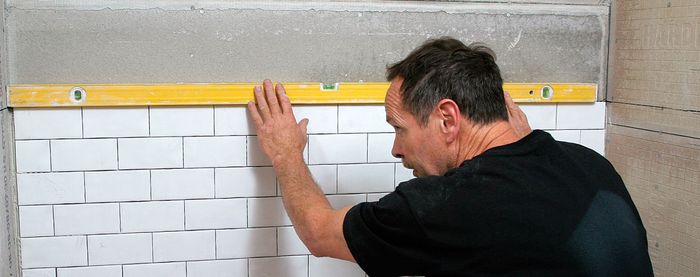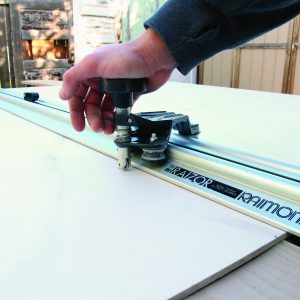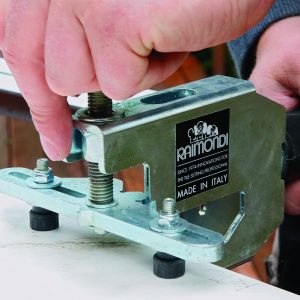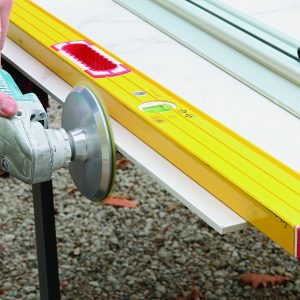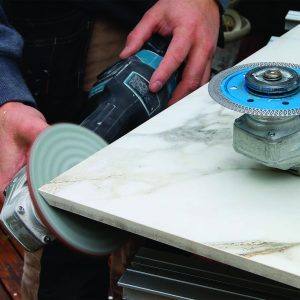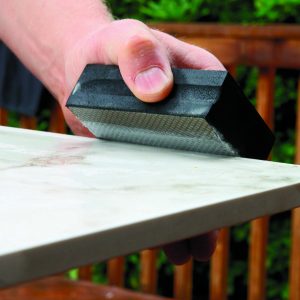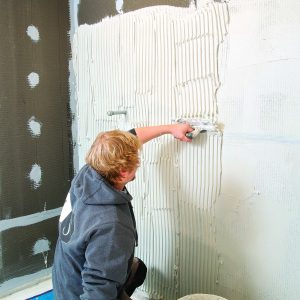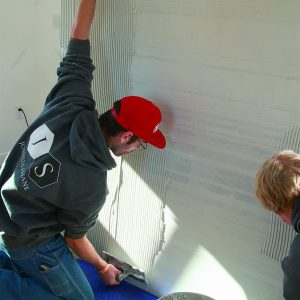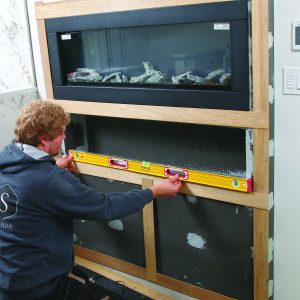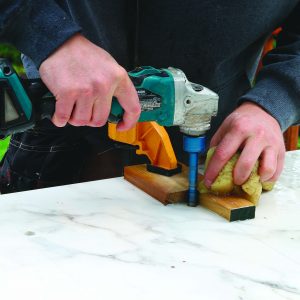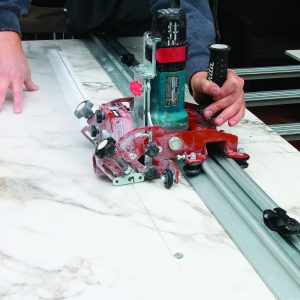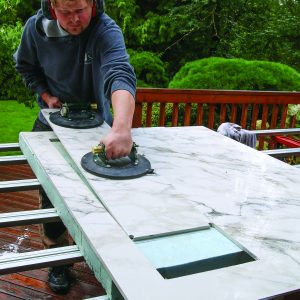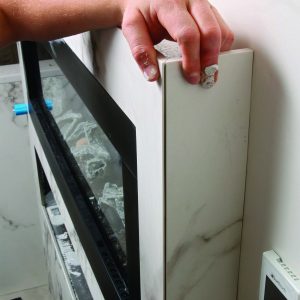The Future of Tile Is Big
Full-wall porcelain panels offer the seamless look of stone with less cost and maintenance.
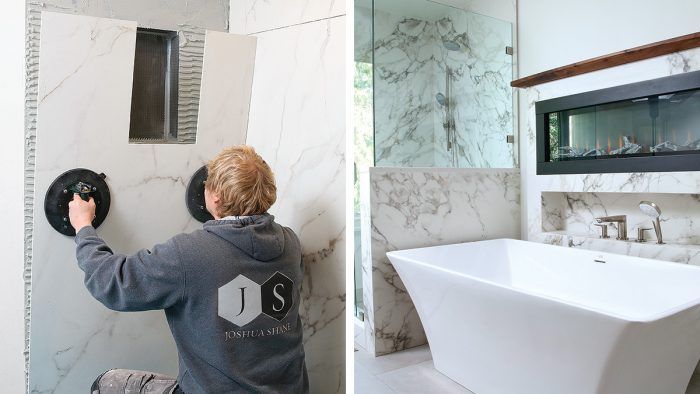
Synopsis: Big-slab tile delivers the rich look of marble with much less maintenance and much lower cost than a thick stone slab. Builder, remodeler, and tilesetter Joshua Oduin explains the basics of porcelain-slab tile, including installation considerations and costs and tips and tools for safe handling. Using photos of a recent project, he details the process of cutting the tile, setting the slabs, and using templates for complex layouts.
Supertough and virtually stainproof and waterproof, porcelain tile is the undisputed champion of the modern bathroom. The latest development— and a logical extension of the big-tile trend—is full-wall porcelain panels, which nearly eliminate grout lines, delivering the rich look of marble with much less maintenance. Better yet, big-slab porcelain tile has an installed cost that’s 30% to 40% less than thick stone slabs.
Porcelain-slab basics

Large porcelain slabs are known formally as gauged porcelain tile panels (GPTP), with “gauged” referring to their precise thicknesses. The most common thicknesses are 6 mm (roughly 1/4 in.), the bread-and-butter choice for residential builders, and 12 mm (1/2 in.). The 6-mm panels are much lighter—160 lb. for a 10-ft. by 5-ft. slab vs. 320 lb. for the same size 12-mm panel— they’re easier to snap and cut, and their edges are quicker to polish.
The 6-mm slabs also make it easier to avoid lippage and misalignment, a notable perk because these huge panels are often bowed by the manufacturing process, and a thinner, more flexible slab makes that much easier to deal with.
While much lighter than quarried stone, big porcelain panels are still far heavier than other tile formats, and less forgiving of inconsistencies in the flatness of walls and substrates. So the learning curve is significant, even for experienced tilesetters. At prices up to $1000 per panel, you can’t afford to damage one or make a slight mistake in layout or cutting. You’ll need to make an initial investment in specialized tools and gear, and a three-person crew is the minimum for safe handling.
The new tools and challenges are why I strongly recommend that anyone seriously interested in large porcelain slabs take one of the excellent training courses conducted by regional retailers and wholesalers such as MSI, Daltile, Crossville, and Bedrosians. Even after 16 years of tilesetting, I jumped at the chance to practice using these new tools and techniques on the manufacturer’s mate-rial and not my clients’. The investment paid off quickly, and today big-slab work is both fun and rewarding for me, my crew, and my customers.
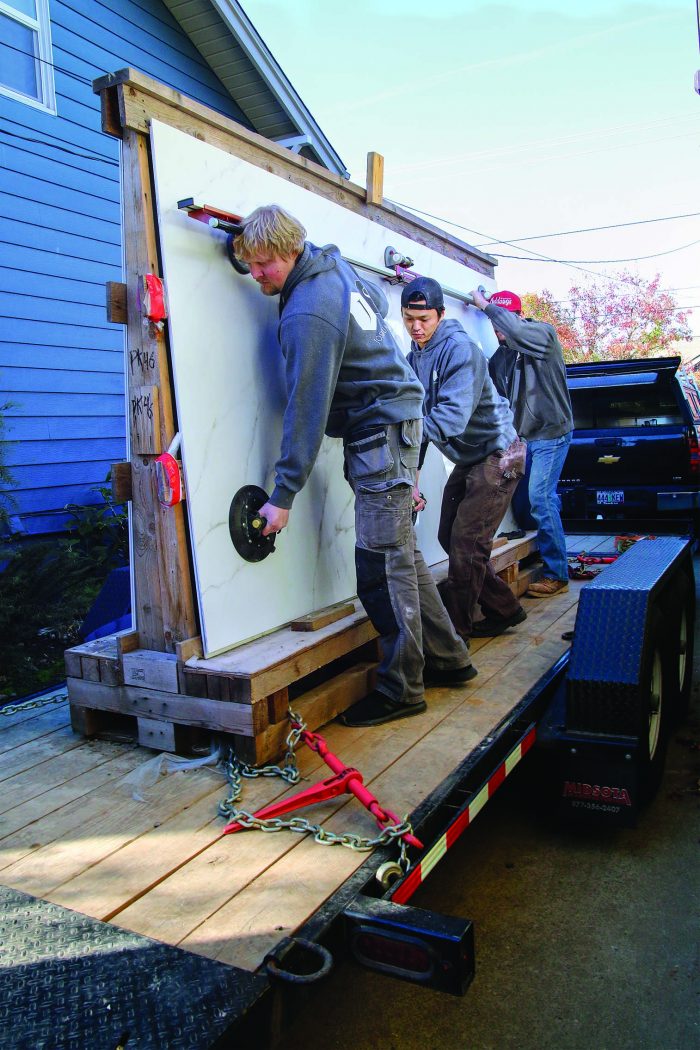
Designing and planning for slabs
Before anything else, you’ll want to plan how the panels will fit into the space you are finishing. Wall widths, ceiling heights, and access are all factors, and some slabs can be ordered in only one size. If a wall is bigger than a single slab, you need to decide where the seams should go.
Because the lifelike veining patterns are manufactured, porcelain slabs can be offered in matched sets of up to four, allowing a skilled tilesetter to “roll the grain” around corners, creating shower curbs and pony walls that look like solid stone, and walls that flow into each other.
To ensure a dead-flat substrate, I frame my own walls whenever possible, power-planing and shimming studs as needed. Other tricks include wet-setting the backer board—put-ting thinset on studs and joists to fill and sup-port lows—or creating the shower floor with a full mud bed.
The floor tile goes in after the wall tile, but I build the shower pan and complete the waterproofing ahead of time, of course, before any tile goes in. In showers, I go with a mud bed instead of a foam-based pan because the mortar is much stronger and more rigid, with no chance of compressing or deflecting over time.
As for the floor profile in a shower, I either angle the whole surface in one plane toward a linear drain, or angle multiple planes toward a center drain, templating the finished pan to create an “envelope” array of tile.
Scoring and Snapping
For edge-to-edge cuts, or butt-joined inside-corner cuts, tile slabs can be scored and snapped like glass using some specialty tools. But when joining panels on an outside corner I prefer to snap and then miter both pieces for a cleaner, more convincing finished look.
Tips and tools for safe handling
The first challenge in working with porcelain slabs is transporting the thin, heavy panels. Like glass companies do, I use a wood A-frame setup, which is bolted onto a standard trailer. For the rest of the process—carrying, cutting, and setting the slabs—you’ll need a handful of specialized tools developed in Europe, where the trend started, available from industry leaders Raimondi, Sigma, Montolit, Omni Cubed, and ETM (European Tile Masters).
Two initial tools are critical for moving the thin panels safely on and off the trailer and fabrication table, and moving them carefully through the house and precisely into place. These are suction-cup handles and a stabilizer frame that stiffens the panel for trans-port, and also attaches with suction cups.
You’ll also need a big, flat, portable cutting table, which is the first thing you’ll set up on the job site. Some installers get away with sawhorses and a big slab door of some kind, but I prefer my light, flat, modular worktable from Raimondi, which is made for the job and folds up for transport and storage.
Setting Slabs
Large, thin slabs require tighter tolerances for the substrate. I only allow substrate flatness to vary by 1⁄8 in. or less overall so the thinset bonds properly. I also apply notched coats of medium-bed thinset mortar, including an initial scratch coat to ensure a strong bond, to both the substrate and the panel. A thicker coat of thinset helps fill the gaps caused by slightly bowed panels (almost all of them are) and any minor inconsistencies in the substrate.
Be ready for a variety of cuts
For straight cuts and straightforward cut–outs, I trust my tape, knowing I can make slight adjustments when installing parts and panels. For anything trickier, I make a template using 1⁄8-in. plywood.
Accuracy is key—you need every edge to come out plumb, level, and square. I use a self-adjusting laser level for this, plus large squares. For end-to-end cuts across an entire panel (or stopped cuts, which end at a cut already made) you can snap porcelain slabs like glass. The first step is scoring, which is done with a tool that rides on a rail that attaches to the tile with more suction cups, the big-slab tilesetter’s best friend. You just line up the scoring point with your layout marks, lock down the cups, and scratch a line across the slab. One thing I learned early on is to wet the suction cups slightly before switching them on, so there’s no chance they’ll shift.
After scoring the slab, fracture it at each end of the score lines using small pliers designed for the job. Apply pressure until you hear or see a faint crack (you’ll almost always hear it). The overhanging offcut usually breaks as you snap the second end, so be sure someone is supporting it. Sometimes I have to return to the first end to use the snap pliers there again, but once the score line snaps, the break usually happens all at once simply from the weight of the tile or with a light push downward.
For inside corners and cutouts, with cuts that need to stop at a precise mark, I use the Raimondi Power Raizor plunge saw, which rides on the same rails the scoring system uses. It uses a diamond wheel to make cuts in a single, slow pass.
I like to miter outside joints, wrapping the marble veining around the corners for a seamless look. While the Power Raizor can tilt to 45°, I find that it’s quicker and cleaner to cut miters by making a square snap cut or plunge cut first, and then creating the miter freehand with a grinder and diamond wheel, using the square edge as my guide and cut-ting the miter a bit beyond 45° to ensure the joint comes together tight on the show side.
A big payoff
As with any large-format tile, a leveling system is required when installing porcelain slabs. For flat walls, I like the broad pressure of a clip-and-wedge system, like Acufloor leveling spacers. When the floor has a number of angled planes, I prefer the spinner type, which have a smaller footprint.
Panel manufacturers recommend 1⁄8-in. grout lines between slab tiles in the field, and a 1⁄8-in. space where they meet adjacent surfaces, such as inside corners. In my experience, 1⁄16 in. is enough between panels, but I stick with the recommended gap at the adjacent edges to allow the framing to expand and contract, especially in a humid bath-room. Those corners get silicone caulk for the same reason, color-matched to the grout used in the field—but avoid silicone seal-ant between panels, as it tends to hold dirt. Epoxy grout is a better choice for field joints.
I can do a standard porcelain-tile installation for about $25 to $35 per sq. ft., including all necessary materials, backer and waterproofing systems, and installation. Large-format porcelain tile, with pieces 2 ft. by 4 ft. in size, will land somewhere around $35 to $55 per sq. ft., altogether. The porcelain slabs we’re talking about here will be in the neighborhood of $65 to $80 per sq. ft.—a significant jump in price, but still less than I need in the budget to install quarried stone, which typically lands at about $100 to $125 per sq. ft. here in the Pacific Northwest.
And once I tell my clients that they can say goodbye to cleaning miles of grout joints, have the look of true marble at a fraction of the cost and maintenance, and be kinder to the planet in the process, big-slab tile is an easy sell.
Templates and Plunge Cuts
For complex layouts like this bathroom-fireplace surround, it’s best to make templates, just like when preparing to install countertops. But unlike cutting to length and width, cuts in the center of a slab require a different procedure.

From FineHomebuilding #292
To view the entire article, please click the View PDF button below.
More about tile setting:
Job-Site Diaries: Dry-Pack Shower – Watch remodeler Joshua Oduin explain the details and techniques that he uses to install and waterproof a dry-pack concrete shower pan.
Installing Large-Format Tile – In this episode of Job-Site Diaries, watch remodeler Josh Oduin prep and place giant tiles for a custom curbless shower.
Prepping for Tile – Schluter waterproofing and uncoupling membranes cover nearly every surface in the Kentucky FHB House bathroom before the tile goes down.
